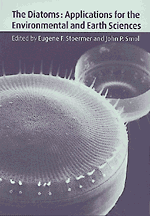Book contents
- Frontmatter
- Contents
- Contributors
- Preface
- Part I Introduction
- Part II Diatoms as indicators of environmental change in flowing waters and lakes
- Part III Diatoms as indicators in extreme environments
- Part IV Diatoms as indicators in marine and estuarine environments
- Part V Other applications
- 18 Diatoms and archeology
- 19 Diatoms in oil and gas exploration
- 20 Forensic science and diatoms
- 21 Toxic and harmful marine diatoms
- 22 Diatoms as markers of atmospheric transport
- 23 Diatomite
- Part VI Conclusions
- Glossary, and acronyms
- Index
19 - Diatoms in oil and gas exploration
Published online by Cambridge University Press: 16 January 2010
- Frontmatter
- Contents
- Contributors
- Preface
- Part I Introduction
- Part II Diatoms as indicators of environmental change in flowing waters and lakes
- Part III Diatoms as indicators in extreme environments
- Part IV Diatoms as indicators in marine and estuarine environments
- Part V Other applications
- 18 Diatoms and archeology
- 19 Diatoms in oil and gas exploration
- 20 Forensic science and diatoms
- 21 Toxic and harmful marine diatoms
- 22 Diatoms as markers of atmospheric transport
- 23 Diatomite
- Part VI Conclusions
- Glossary, and acronyms
- Index
Summary
Introduction
Diatoms constitute an important rock-forming microfossil group. Unlike other microfossils, they evolved rapidly during the late Cenozoic and are found in marine, brackish water, and lacustrine sediments, and are thus useful tools for age dating and correlating sediments that accumulated in a variety of environments. Their fossil assemblages are reflective of the environments in which they lived, and their recovery in wells and outcrops can provide information on paleochemistry and paleobathymetry. They are most useful to the oil and gas industry in age dating and correlating rocks that lack or have poor recovery of useful calcareous microfossils, such as ‘cold water’ late Tertiary marine rocks, and sediments that accumulated in lacustrine basins and in brackish water settings.
Age dating and correlation of sedimentary rocks are important for hydrocarbon exploration in order to understand the geologic history of a basin as it relates to the formation of source rocks, reservoirs, structures, and seals. The timing of expulsion of oil and gas is a critical factor in determining the prospectivity of a basin for hydrocarbon, and necessitates an understanding of the geochronology of events. The ability to correlate subsurface rocks is a prerequisite to mapping the distribution of reservoir facies and the interpretation of sequence stratigraphy.
Environmental data pertaining to paleobathymetry and paleochemistry provide important information on the geologic history of a basin and the predictability of reservoir distribution. For example, shales barren of calcareous microfossils may have accumulated in deep water, beneath the carbonate compensation depth, or in brackish or freshwater. The incorrect interpretation will drastically affect the interpretation of a basin's evolution and the evaluation of its hydrocarbon potential.
- Type
- Chapter
- Information
- The DiatomsApplications for the Environmental and Earth Sciences, pp. 402 - 412Publisher: Cambridge University PressPrint publication year: 1999
- 5
- Cited by



